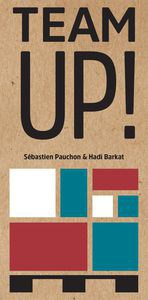It always fascinates when a game can be stored in a relatively small box, and yet once on the table the limited contents can hold a player’s attention so well.
But that is exactly what Team UP! From designers Hadi Barkat, and Sébastien Pauchon.
The first thing that caught my attention was that the components for Team UP are all wooden. I simply find wooden game pieces to be aesthetically more pleasing than plastic, and as a result I probably have something of a bias toward wooden games, but in this case it really does look sharp.
In terms of game play, Team UP from the publisher Helvetiq, is a cooperative game: you are not opponents, you are partners. This creates an interesting dynamic that is not part of most games.
The team are trying to do the best possible job of packing ‘boxes’ onto a pallet. (It should be noted here that you can play this solitaire quite well).
“The goal of the game is to stack the boxes on the pallet as compactly as possible. The more full layers you stack, the more points you win. A perfect pallet is worth exactly 25 points,” explains the rules.
The ‘boxes’ are wooden cubes of varying shapes, as well as having one side painted a colour, which becomes important as the game develops.
Players draw cards from a deck which indicates the block colour you must use from the remaining blocks; or the shape you must use from the remaining blocks, regardless of the colour.
In placing the boxes there are a number of rules to follow, but all are very easy to follow. For example a newly placed box must touch at least one other box, (there is a starting box placed each game), and the coloured side of the box must face up.
A lot of the rules are simply common sense in terms of how you would imagine packing a pallet. For example, a box cannot extend past the boundaries of the pallet.
Boxes may not overhang or ‘float’ above empty space. The box must be in full contact with the pallet or with one or several boxes below.
The game ends if any of the following three situations occurs:
All of the boxes have been stacked on the pallet, possible, but rare.
There are no more cards in the draw pile.
The players mutually agree to stop drawing new cards as the risk of penalties has become too high.
Scoring is done in three steps:
Count the number of layers that are 100 per cent complete. Each on is worth five points.
Deduct one point for each box that was not stacked on the pallet.
Deduct one point for each card placed face down in the discard pile.
Apparently there is one known solution to achieving perfection, but reasonably it won’t happen since the cards would need to be in a particular order and a player would then have to make the perfect placement each turn, too.
So reasonably you shoot for 20 points, and will generally have a piece or two orphaned, so 18 is likely the target that says you did as well as can generally be expected.
There is replay here as you tend to want to try to do better, and there are simple rules for challenging friends to do better based on the same card draws, that are fun too.
The quick game play, good looks, and ‘I can do better’ allure of Team Up! certainly make this a great time filler to add to a collection.
Check it out at www.helvetiq.com.
Thanks to fellow gamers Jeff Chasse, Trevor Lyons and Adam Daniels for their help in running through this game for review.



